Thermal-Hydraulic Characteristics of Carbon Dioxide in Printed Circuit Heat Exchangers with Staggered Airfoil Fins
Abstract
:1. Introduction
2. Mathematical Model and Solution Methods
2.1. Gometric Model
2.2. Governing Equations and Boundary Conditions
2.3. Performance Measures
2.4. Verification of Numerical Results
3. Results and Analysis
3.1. Analysis of Heat Transfer Characteristics
3.2. Analysis of Flow Characteristics
3.3. Analysis of Comprehensive Performance
4. Summary
- (1)
- The convective heat transfer coefficient was the largest under the trans-critical operating condition, 3.96-fold higher than that observed under the far-critical operating condition and 2.74-fold higher than that observed under the near-critical operating condition. The trans-critical operating condition contributed to a larger fanning friction factor, higher density, lower flow velocity, and lower inlet-out pressure drop than those of the far-critical and near-critical operating conditions. The trans-critical operating condition yielded the best comprehensive performance.
- (2)
- As the fin height increased, the cross-sectional area of the channel decreased, flow velocity increased, heat transfer enhanced, and pressure loss increased. Fin height significantly affected the occurrence position and morphology of vortex flows in the transverse cross-sections of the channel.
- (3)
- Compared with the channel with connected fins, the channel with unconnected fins which height is 0.6 mm attained a comparable comprehensive performance but reduced the volume of fins by 50%. Therefore, it achieved a more lightweight PCHE design. The thermo-hydraulic performance was the poorest when the fin height was extremely close to the channel height, which should be avoided during the design of airfoils for PCHEs.
Author Contributions
Funding
Data Availability Statement
Conflicts of Interest
References
- Aneesh, A.M.; Sharma, A.; Srivastava, A.; Vyas, K.; Chaudhuri, P. Thermal-hydraulic characteristics and performance of 3D straight channel based printed circuit heat exchanger. Appl. Therm. Eng. 2016, 98, 474–482. [Google Scholar] [CrossRef]
- Chai, L.; Tassou, S.A. A review of printed circuit heat exchangers for helium and supercritical CO2 Brayton cycles. Therm. Sci. Eng. Prog. 2020, 18, 100543. [Google Scholar] [CrossRef]
- Huang, C.; Cai, W.; Wang, Y.; Liu, Y.; Li, Q.; Li, B. Review on the characteristics of flow and heat transfer in printed circuit heat exchangers. Appl. Therm. Eng. 2019, 153, 190–205. [Google Scholar] [CrossRef]
- Ma, T.; Li, M.J.; Xu, J.L.; Cao, F. Thermodynamic analysis and performance prediction on dynamic response characteristic of PCHE in 1000 MW S-CO2 coal fired power plant. Energy 2019, 175, 123–138. [Google Scholar] [CrossRef]
- Figley, J.; Sun, X.; Mylavarapu, S.K.; Hajek, B. Numerical study on thermal hydraulic performance of a Printed Circuit Heat Exchanger. Prog. Nucl. Energy 2013, 68, 89–96. [Google Scholar] [CrossRef]
- Saranam, V.R.; Paul, B.K. Feasibility of Using Diffusion Bonding for Producing Hybrid Printed Circuit Heat Exchangers for Nuclear Energy Applications. Procedia Manuf. 2018, 26, 560–569. [Google Scholar] [CrossRef]
- Mohammed, R.H.; Alsagri, A.S.; Wang, X. Performance improvement of supercritical carbon dioxide power cycles through its integration with bottoming heat recovery cycles and advanced heat exchanger design: A review. Int. J. Energy Res. 2020, 44, 7108–7135. [Google Scholar] [CrossRef]
- Marchionni, M.; Bianchi, G.; Tassou, S.A. Review of supercritical carbon dioxide (sCO2) technologies for high-grade waste heat to power conversion. SN Appl. Sci. 2020, 2, 611. [Google Scholar] [CrossRef] [Green Version]
- Ma, Y.; Xie, G.; Hooman, K. Review of printed circuit heat exchangers and its applications in solar thermal energy. Renew. Sustain. Energy Rev. 2021, 155, 111933. [Google Scholar] [CrossRef]
- Wang, K.; He, Y.L.; Zhu, H.H. Integration between supercritical CO2 Brayton cycles and molten salt solar power towers: A review and a comprehensive comparison of different cycle layouts. Appl. Energy 2017, 195, 819–836. [Google Scholar] [CrossRef]
- Wu, P.; Ma, Y.; Gao, C.; Liu, W.; Shan, J.; Huang, Y.; Wang, J.; Zhang, D.; Ran, X. A review of research and development of supercritical carbon dioxide Brayton cycle technology in nuclear engineering applications. Nucl. Eng. Des. 2020, 368, 110767. [Google Scholar] [CrossRef]
- Ahn, Y.; Bae, S.J.; Kim, M.; Cho, S.K.; Baik, S.; Lee, J.I.; Cha, J.E. Review of supercritical CO2 power cycle technology and current status of research and development. Nucl. Eng. Technol. 2015, 47, 647–661. [Google Scholar] [CrossRef] [Green Version]
- Baek, S.; Hwang, G.; Jeong, S.; Kim, J. Development of compact heat exchanger for LNG FPSO. In Proceedings of the Twenty-First International Offshore and Polar Engineering Conference, Maui, HI, USA, 19–24 June 2011. [Google Scholar]
- Zhao, Z.; Zhang, X.; Zhao, K.; Jiang, P.; Chen, Y. Numerical investigation on heat transfer and flow characteristics of supercritical nitrogen in a straight channel of printed circuit heat exchanger. Appl. Therm. Eng. 2017, 126, 717–729. [Google Scholar] [CrossRef]
- Sarmiento, A.P.C.; Milanez, F.H.; Mantelli, M.B.H. Theoretical models for compact printed circuit heat exchangers with straight semicircular channels. Appl. Therm. Eng. 2020, 184, 115435. [Google Scholar] [CrossRef]
- Xie, J.Y.; Chueh, C.C.; Chen, W.H.; Chen, K. Heat transfer performance comparison of printed circuit heat exchangers with straight, zigzag and serpentine flow channels for waste heat recovery. Int. J. Energy Res. 2021, 46, 1722–1735. [Google Scholar] [CrossRef]
- Bennett, K.; Chen, Y.T. Thermal-hydraulic correlations for zigzag-channel PCHEs covering a broad range of design parameters for estimating performance prior to modeling. Therm. Sci. Eng. Prog. 2019, 17, 100383. [Google Scholar] [CrossRef]
- Zhang, H.; Guo, J.; Huai, X.; Cheng, K.; Cui, X. Studies on the thermal-hydraulic performance of zigzag channel with supercritical pressure CO2. J. Supercrit. Fluids 2019, 148, 104–115. [Google Scholar] [CrossRef]
- Baik, Y.J.; Jeon, S.; Kim, B.; Jeon, D.; Byon, C. Heat transfer performance of wavy-channeled PCHEs and the effects of waviness factors. Int. J. Heat Mass Transf. 2017, 114, 809–815. [Google Scholar] [CrossRef]
- Wen, Z.X.; Lv, Y.G.; Li, Q.; Zhou, P. Numerical study on heat transfer behavior of wavy channel supercritical CO2 printed circuit heat exchangers with different amplitude and wavelength parameters. Int. J. Heat Mass Transf. 2019, 147, 118922. [Google Scholar] [CrossRef]
- Ji, Y.; Xing, K.; Cen, K.; Ni, M.; Xu, H.; Xiao, G. Numerical Study on Flow and Heat Transfer Characteristics of Trapezoidal Printed Circuit Heat Exchanger. Micromachines 2021, 12, 1589. [Google Scholar] [CrossRef]
- Aneesh, A.M.; Sharma, A.; Srivastava, A.; Chaudhury, P. Effects of wavy channel configurations on thermal-hydraulic characteristics of Printed Circuit Heat Exchanger (PCHE). Int. J. Heat Mass Transf. 2018, 118, 304–315. [Google Scholar] [CrossRef]
- Li, Y.; Qiu, Z.; Cui, D.; Wang, Z.; Zhang, J.; Ji, Y. Numerical investigation on the thermal-hydraulic performance of helical twine printed circuit heat exchanger. Int. Commun. Heat Mass Transf. 2021, 128, 105596. [Google Scholar] [CrossRef]
- Saeed, M.; Kim, M.H. Thermal-hydraulic analysis of sinusoidal fin-based printed circuit heat exchangers for supercritical CO2 Brayton cycle. Energy Convers. Manag. 2019, 193, 124–139. [Google Scholar] [CrossRef]
- Jin, F.; Chen, D.; Hu, L.; Huang, Y.; Zeng, H.; Wang, J. Thermo-Hydraulic performance of printed circuit heat exchanger as precooler in supercritical CO2 Brayton cycle. Appl. Therm. Eng. 2022, 210, 118341. [Google Scholar] [CrossRef]
- Wang, K.; Zhang, X.Y.; Zhang, Z.D.; Min, C.H. Three-dimensional shape optimization of fins in a printed circuit recuperator using S-CO2 as the heat-transfer fluid. Int. J. Heat Mass Transf. 2022, 192, 122910. [Google Scholar] [CrossRef]
- Chu, W.X.; Li, X.H.; Ting, M.; Zeng, M.; Wang, Q.W. Heat transfer and pressure drop performance of printed circuit heat exchanger with different fin structures. Chin. Sci. Bull. 2017, 62, 1788–1794. (In Chinese) [Google Scholar] [CrossRef]
- Xu, X.Y.; Wang, Q.W.; Li, L.; Ekkad, S.V.; Ma, T. Thermal-Hydraulic Performance of Different Discontinuous Fins Used in a Printed Circuit Heat Exchanger for Supercritical CO2. Numer. Heat Transf. Part A Appl. 2015, 68, 1067–1086. [Google Scholar] [CrossRef]
- Chen, F.; Zhang, L.; Huai, X.; Li, J.; Zhang, H.; Liu, Z. Comprehensive performance comparison of airfoil fin PCHEs with NACA 00XX series airfoil. Nucl. Eng. Des. 2017, 315, 42–50. [Google Scholar] [CrossRef]
- Tian, Y.; Long, C.; Tang, L. Study on Thermal-Hydraulic Performance of The Printed Circuit Heat Exchanger with Airfoil Fins for Supercritical Liquefied Natural Gas. Front. Heat Mass Transf. 2022, 19, 1–11. [Google Scholar] [CrossRef]
- Wang, W.; Ding, L.; Han, F.; Shuai, Y.; Li, B.; Sunden, B. Parametric Study on Thermo-Hydraulic Performance of NACA Airfoil Fin PCHEs Channels. Energies 2022, 15, 5095. [Google Scholar] [CrossRef]
- Li, X.L.; Tang, G.H.; Fan, Y.H.; Yang, D.L.; Wang, S.Q. Numerical Analysis of Slotted Airfoil Fins for Printed Circuit Heat Exchanger in S-CO2 Brayton Cycle. J. Nucl. Eng. Radiat. Sci. 2019, 5, 041303. [Google Scholar] [CrossRef]
- Cui, X.; Guo, J.; Huai, X.; Cheng, K.; Zhang, H.; Xiang, M. Numerical study on novel airfoil fins for printed circuit heat exchanger using supercritical CO2. Int. J. Heat Mass Transf. 2018, 121, 354–366. [Google Scholar] [CrossRef]
- Xu, X.; Ma, T.; Li, L.; Zeng, M.; Chen, Y.; Huang, Y.; Wang, Q. Optimization of fin arrangement and channel configuration in an airfoil fin PCHE for supercritical CO2 cycle. Appl. Therm. Eng. 2014, 70, 867–875. [Google Scholar] [CrossRef]
- Zhang, H.; Guo, J.; Cui, X.; Zhou, J.; Huai, X.; Zhang, H.; Cheng, K.; Han, Z. Experimental and numerical investigations of thermal-hydraulic characteristics in a novel airfoil fin heat exchanger. Int. J. Heat Mass Transf. 2021, 175, 121333. [Google Scholar] [CrossRef]
- Li, Z.H.; Jiang, P.X.; Zhao, C.R.; Zhang, Y. Experimental investigation of convection heat transfer of CO2 at supercritical pressures in a vertical circular tube. Exp. Therm. Fluid Sci. 2010, 34, 1162–1171. [Google Scholar] [CrossRef]
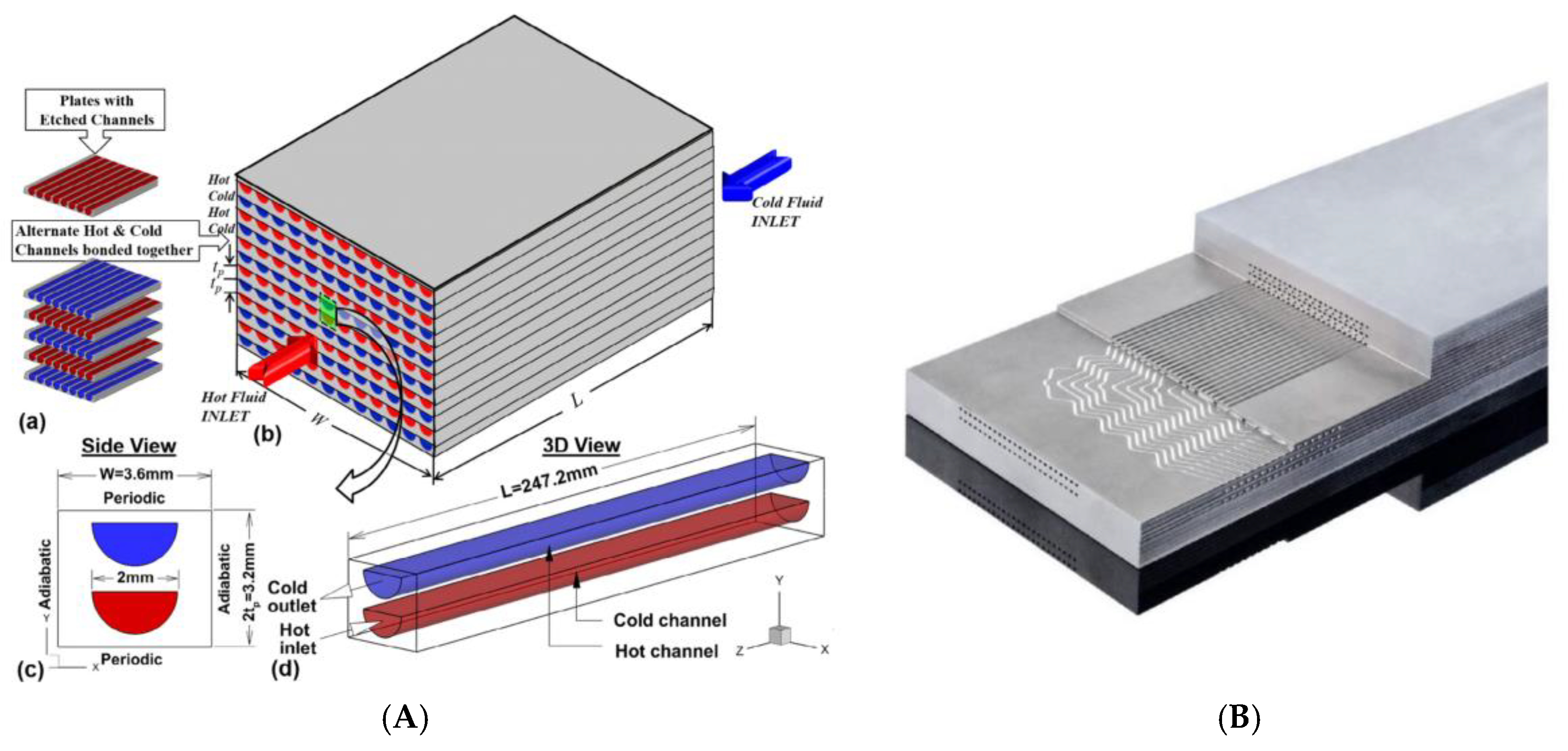

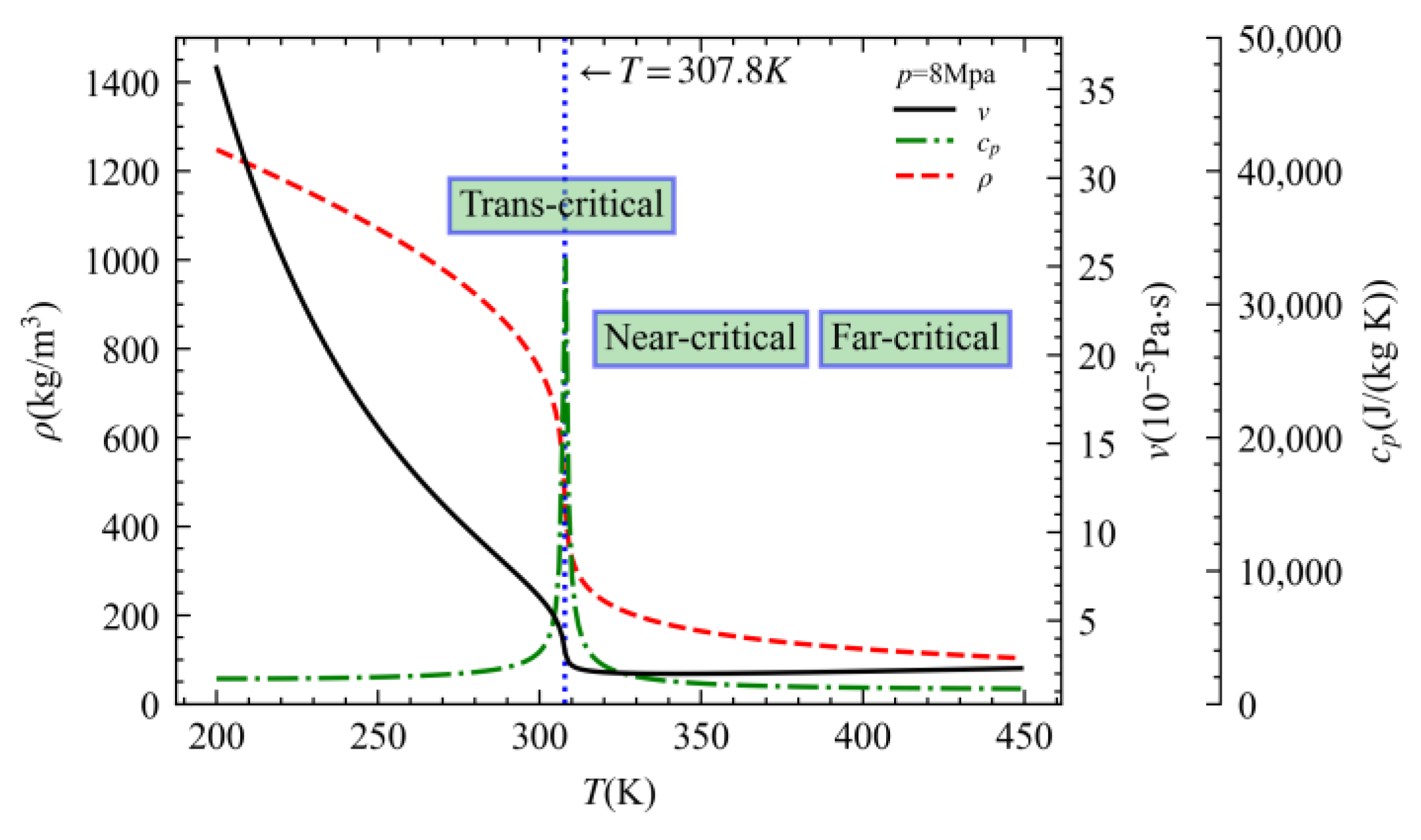

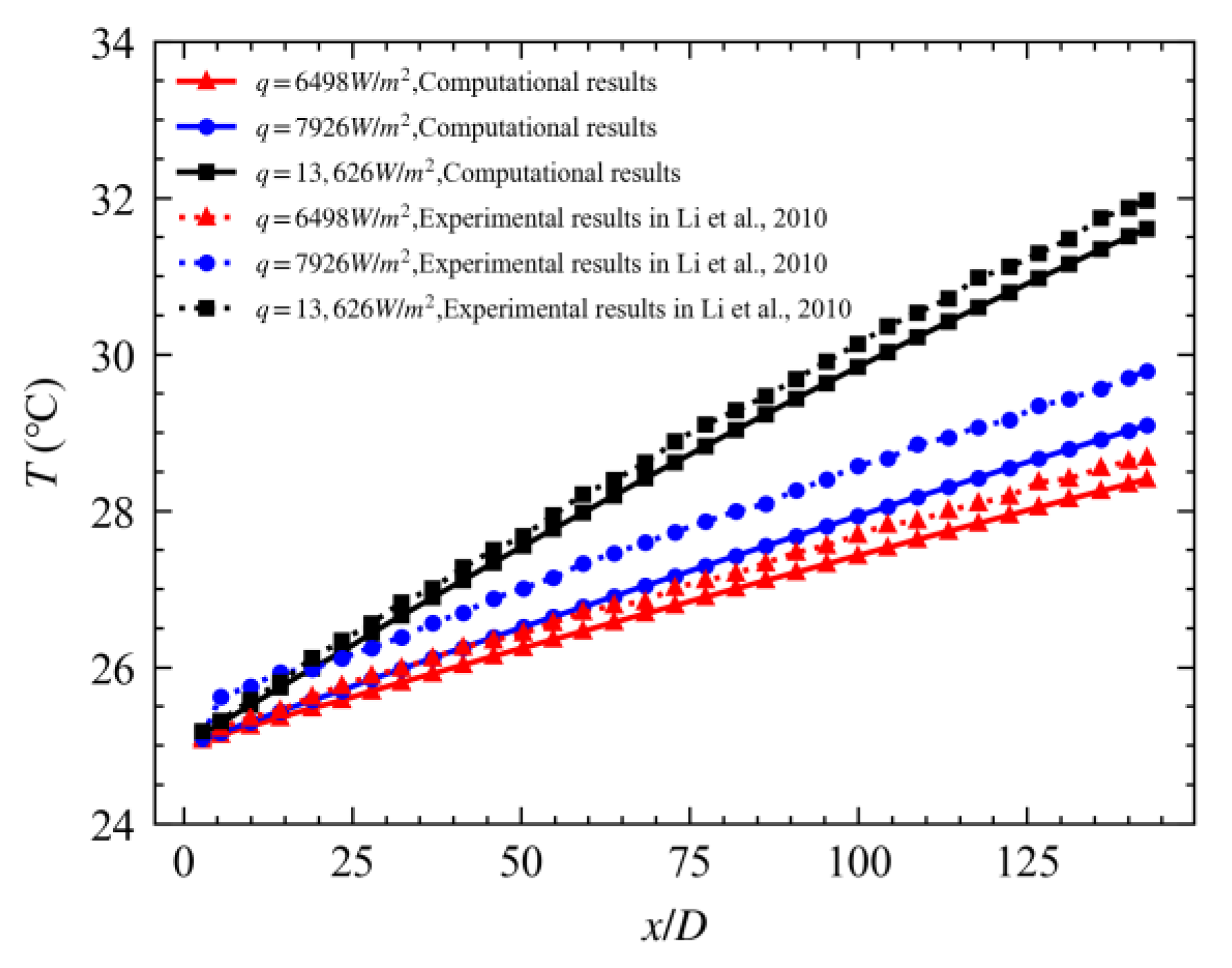

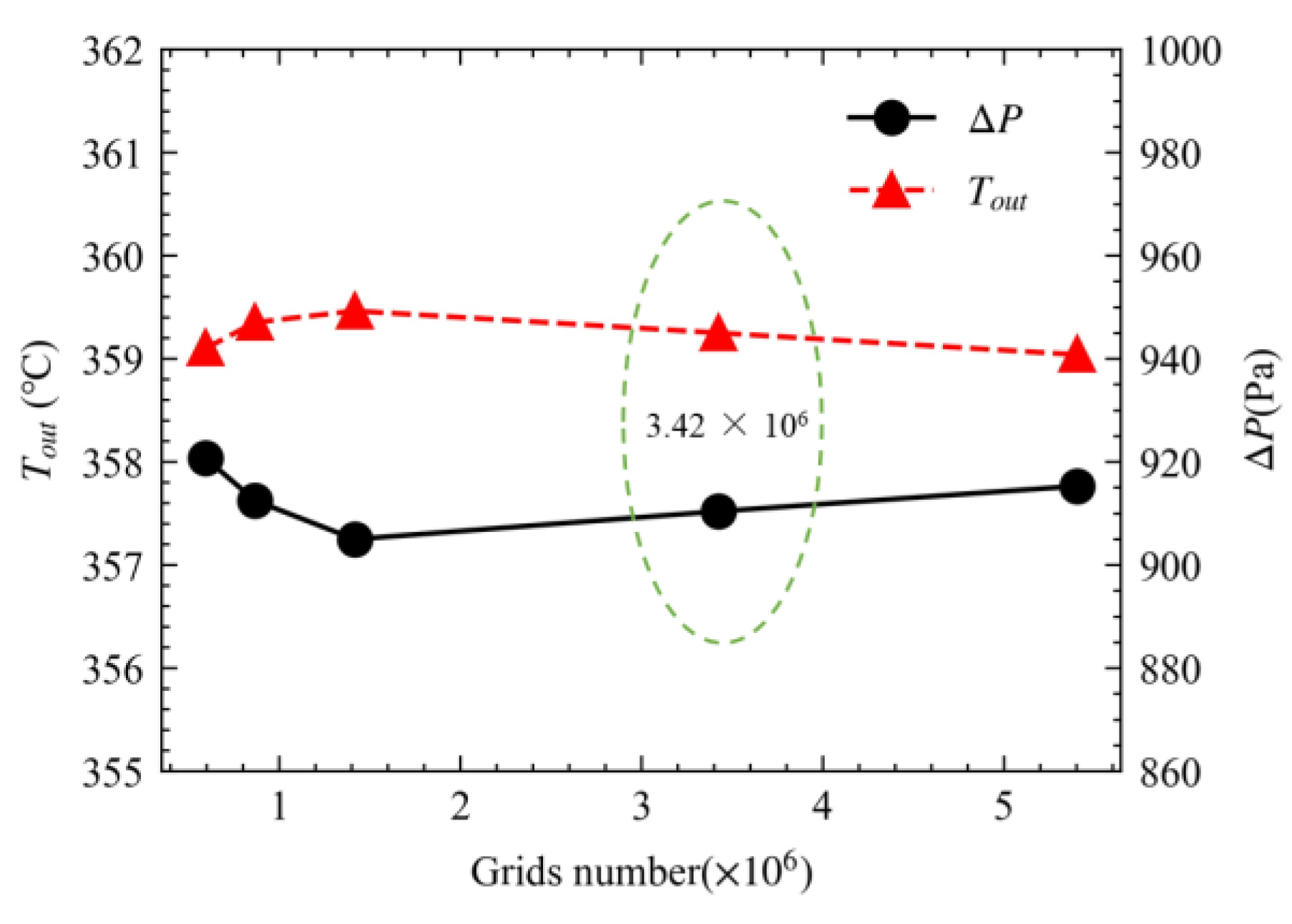



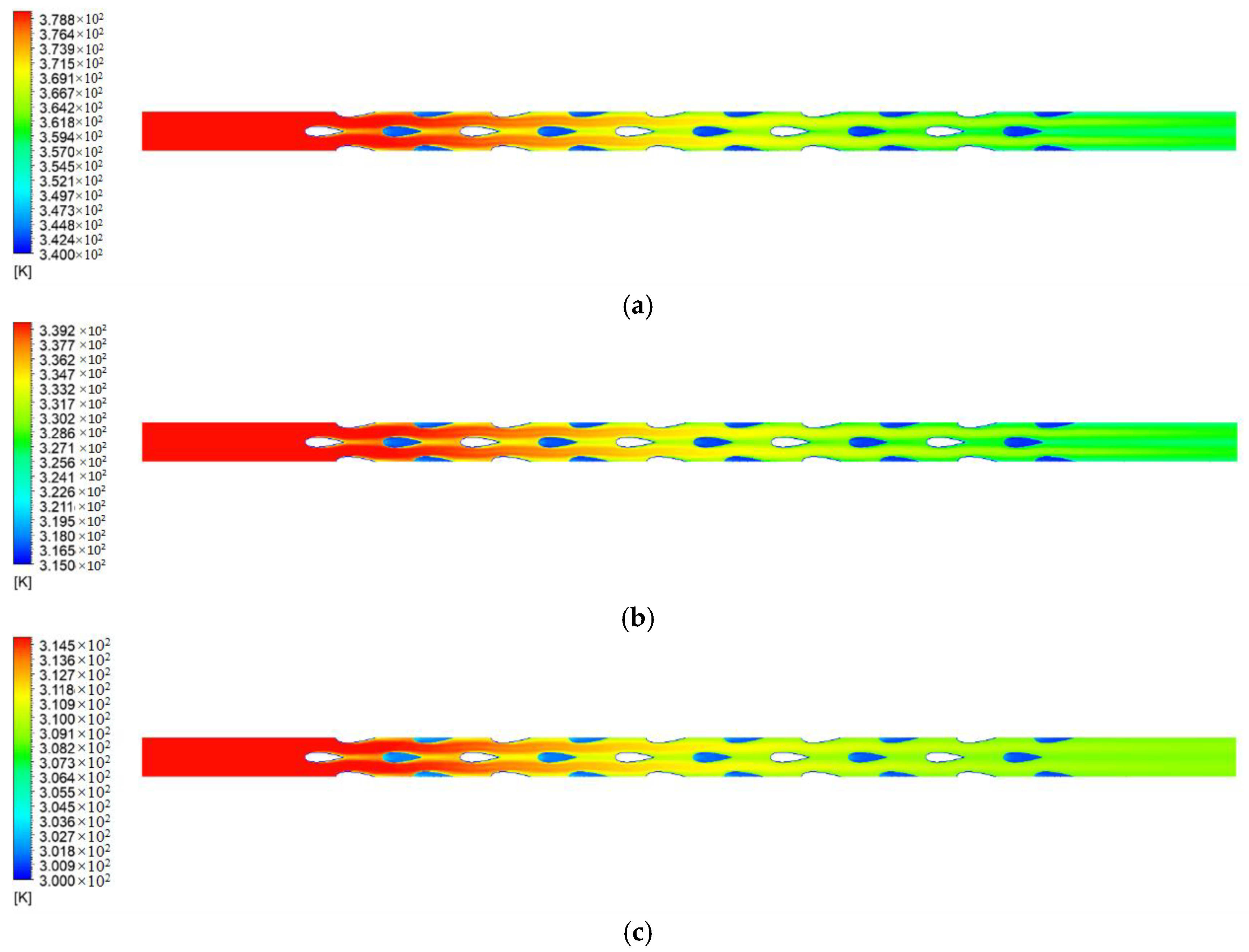
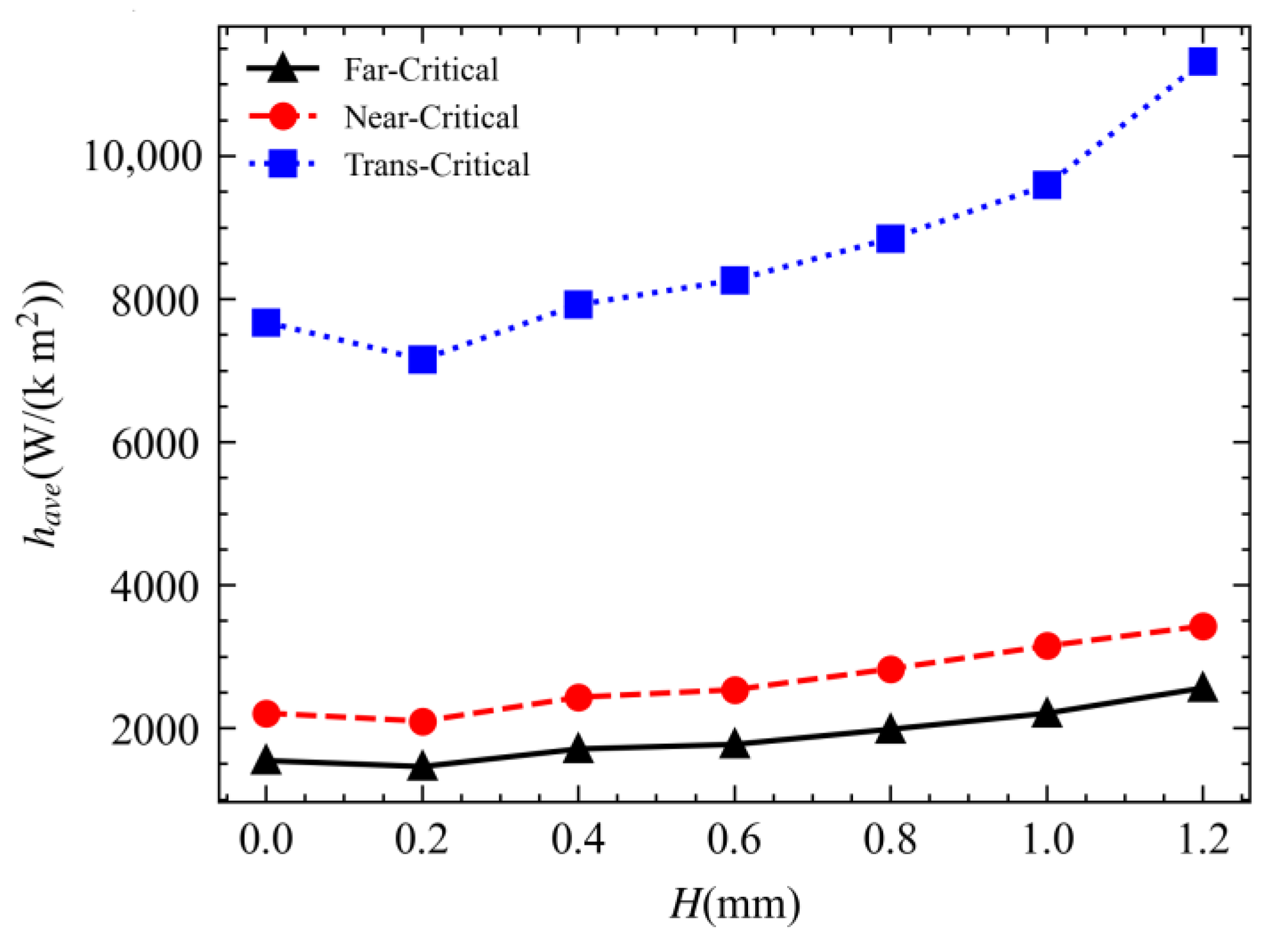


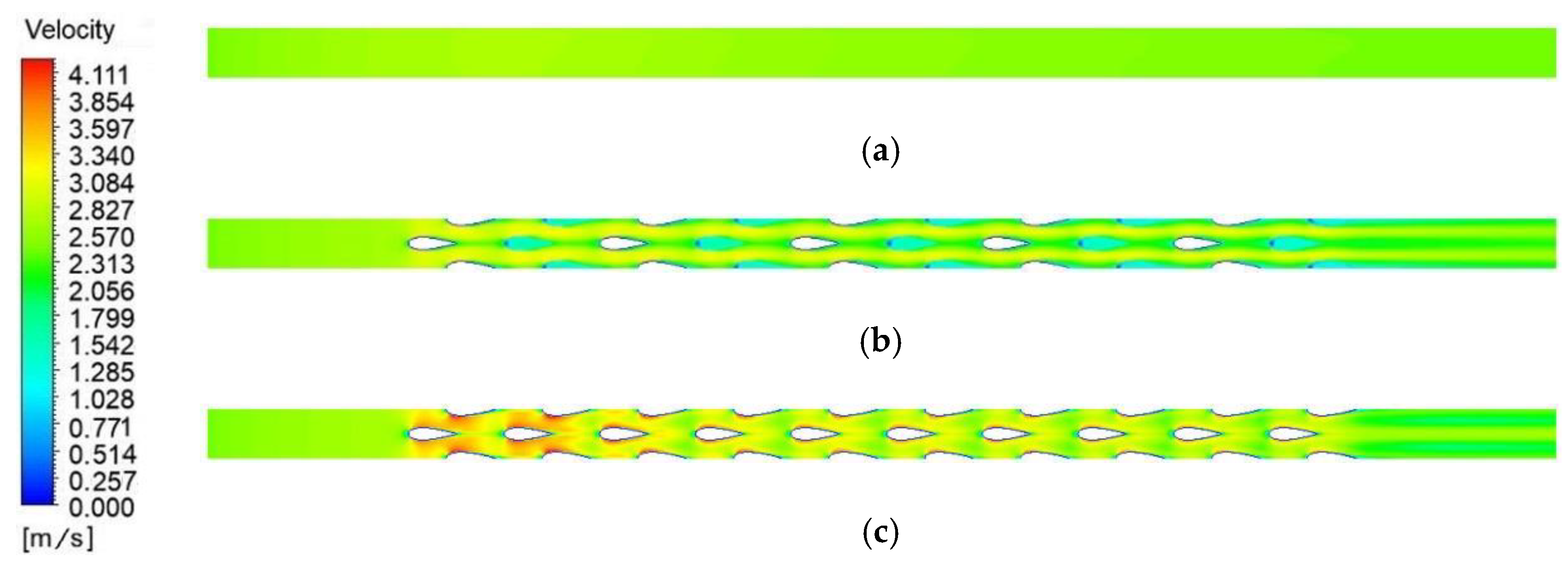
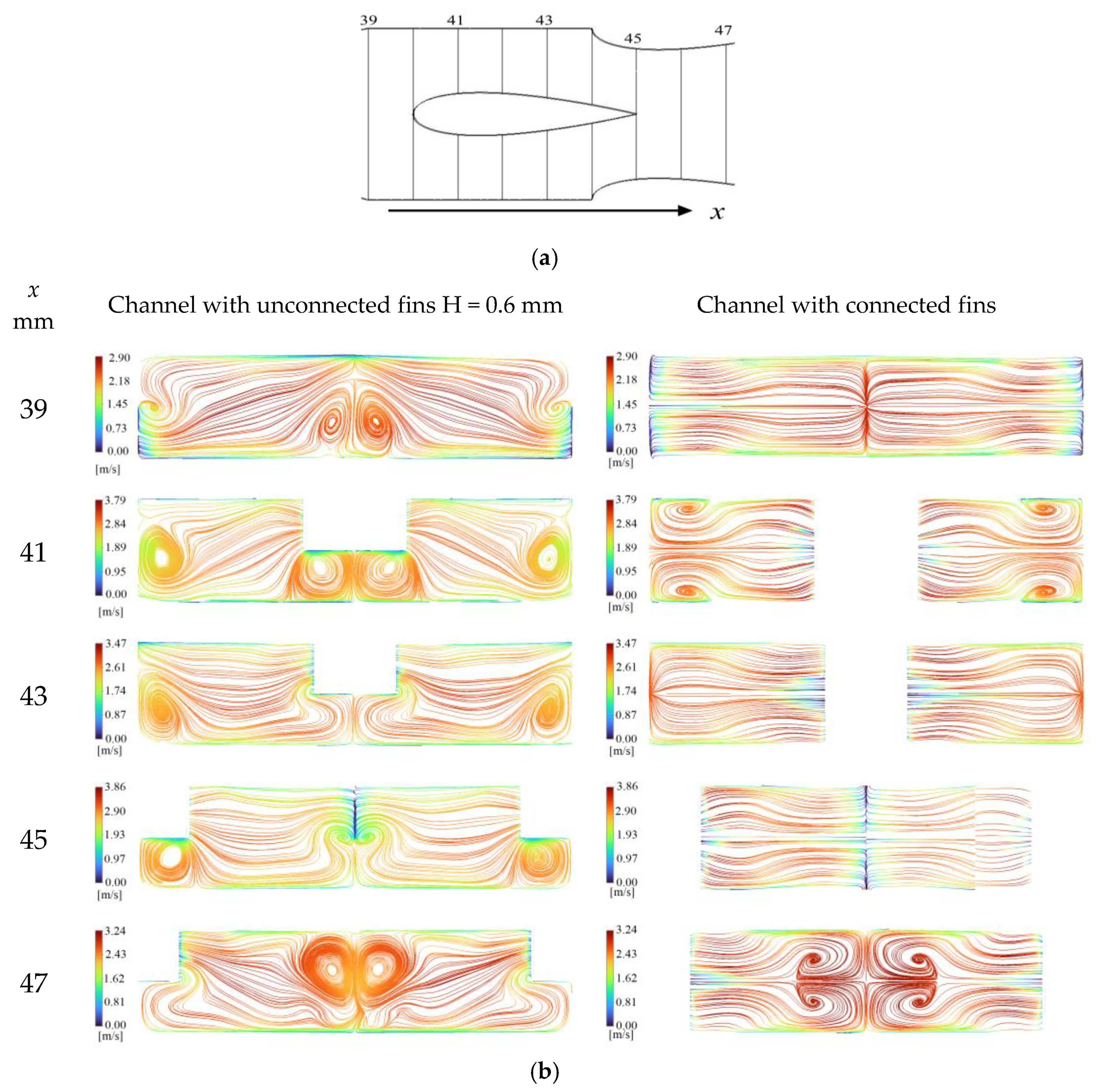

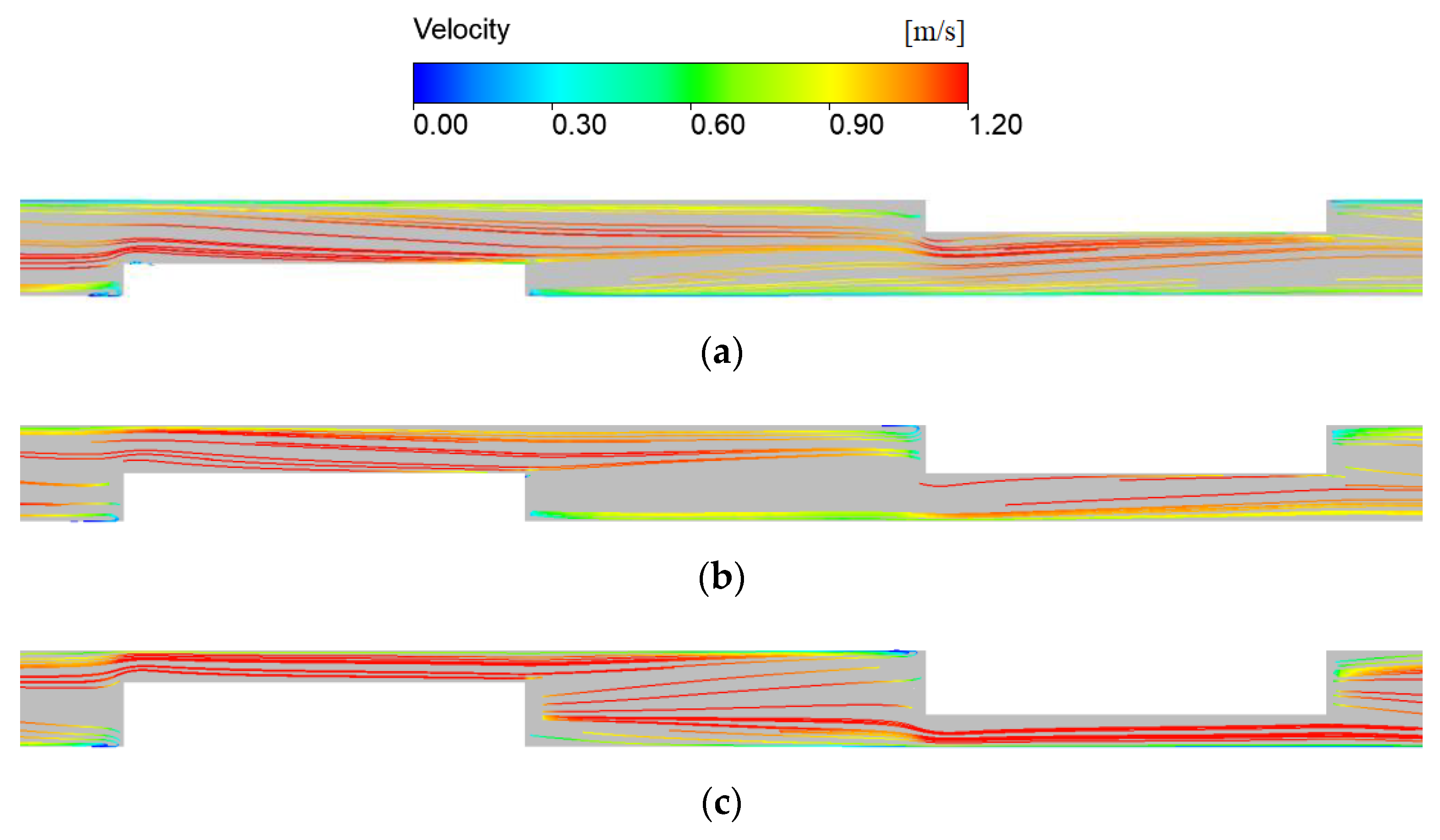
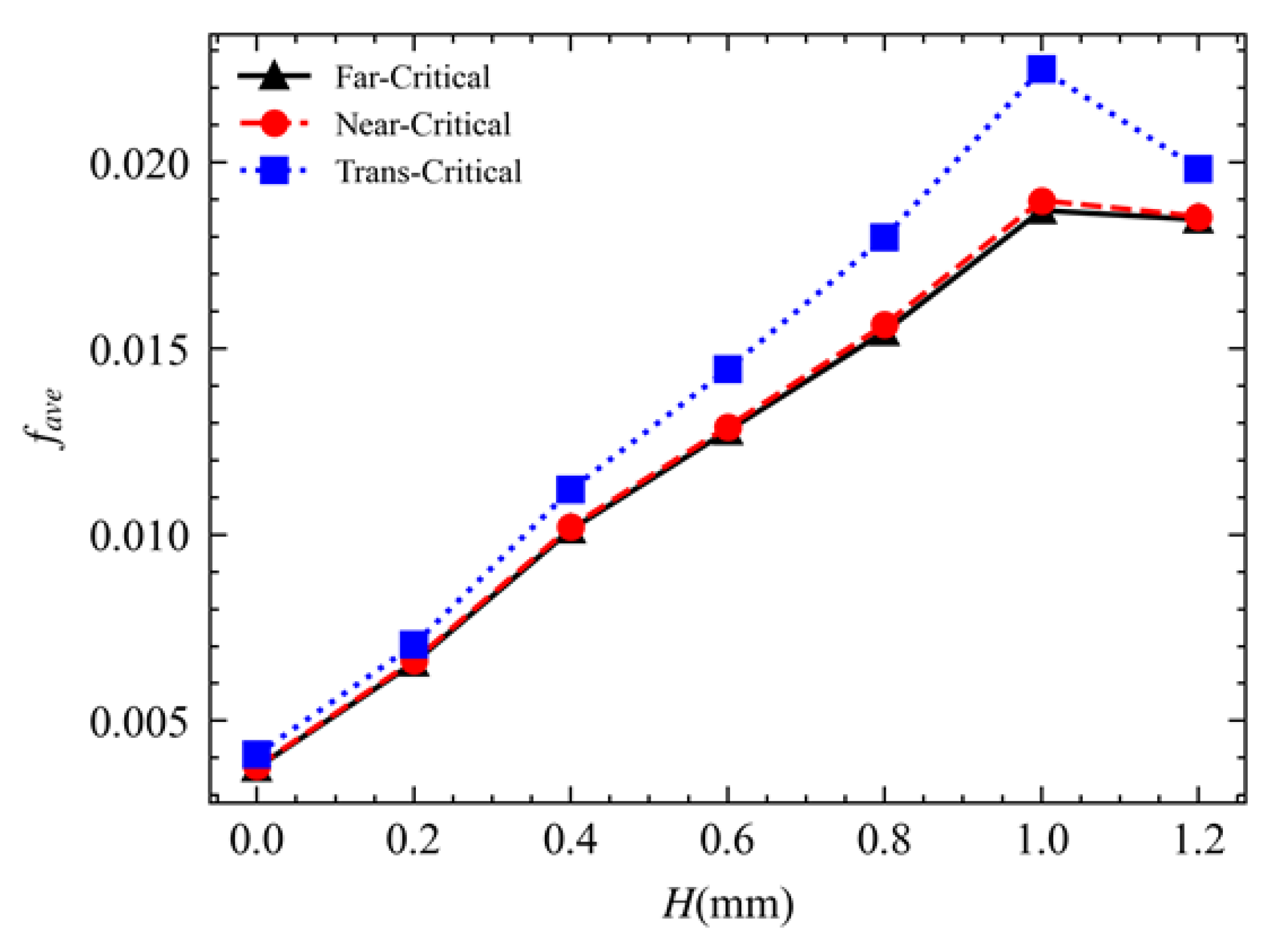
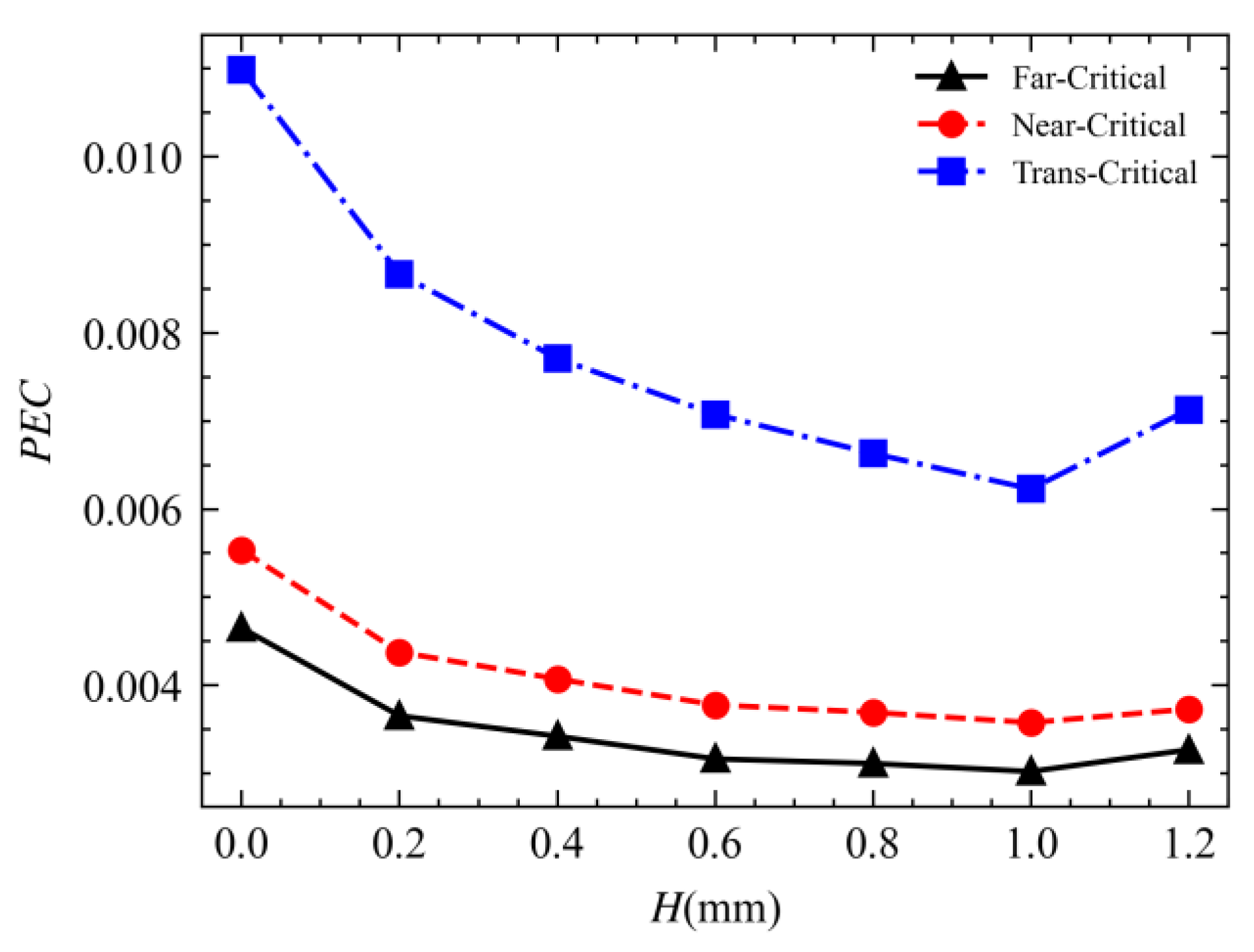
| Operating Condition | Height of Airfoil Fin (mm) | Inlet Mass Flow Rate (g/s) | Wall Temperature (K) | Inlet Temperature (K) | Outlet Pressure (Mpa) |
|---|---|---|---|---|---|
| Far-critical | 0, 0.2, 0.4, 0.6, 0.8, 1.0, 1.2 | 2 | 340 | 380 | 8 |
| Near-critical | 0, 0.2, 0.4, 0.6, 0.8, 1.0, 1.2 | 2 | 315 | 340 | 8 |
| Trans-critical | 0, 0.2, 0.4, 0.6, 0.8, 1.0, 1.2 | 2 | 300 | 315 | 8 |
Disclaimer/Publisher’s Note: The statements, opinions and data contained in all publications are solely those of the individual author(s) and contributor(s) and not of MDPI and/or the editor(s). MDPI and/or the editor(s) disclaim responsibility for any injury to people or property resulting from any ideas, methods, instructions or products referred to in the content. |
© 2023 by the authors. Licensee MDPI, Basel, Switzerland. This article is an open access article distributed under the terms and conditions of the Creative Commons Attribution (CC BY) license (https://creativecommons.org/licenses/by/4.0/).
Share and Cite
Xi, K.; Zhao, X.; Xie, Z.; Meng, F.; Lu, Z.; Ji, X. Thermal-Hydraulic Characteristics of Carbon Dioxide in Printed Circuit Heat Exchangers with Staggered Airfoil Fins. Processes 2023, 11, 2244. https://doi.org/10.3390/pr11082244
Xi K, Zhao X, Xie Z, Meng F, Lu Z, Ji X. Thermal-Hydraulic Characteristics of Carbon Dioxide in Printed Circuit Heat Exchangers with Staggered Airfoil Fins. Processes. 2023; 11(8):2244. https://doi.org/10.3390/pr11082244
Chicago/Turabian StyleXi, Kun, Xiang Zhao, Zhihui Xie, Fankai Meng, Zhuoqun Lu, and Xiangkun Ji. 2023. "Thermal-Hydraulic Characteristics of Carbon Dioxide in Printed Circuit Heat Exchangers with Staggered Airfoil Fins" Processes 11, no. 8: 2244. https://doi.org/10.3390/pr11082244






